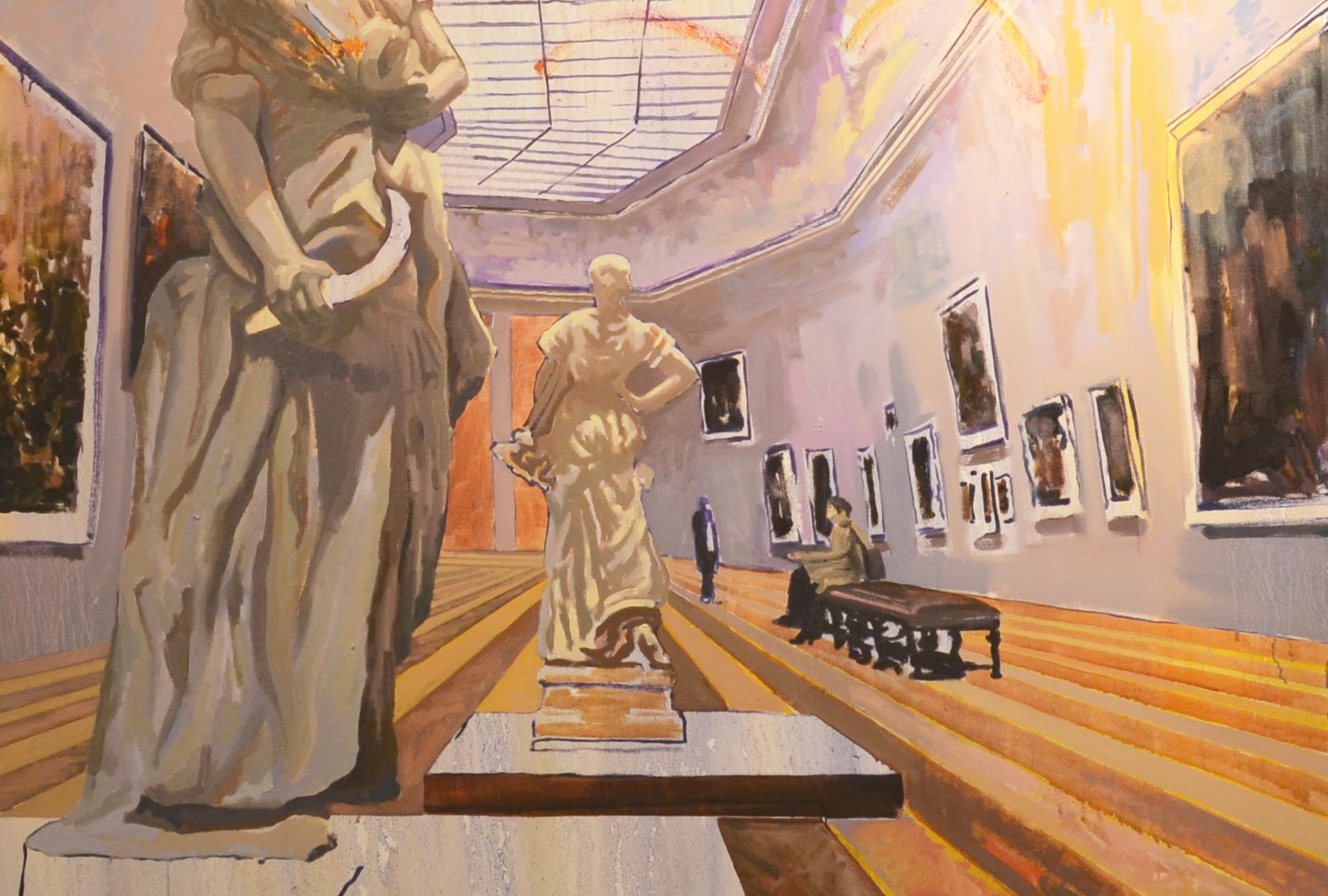Art Professors Chris Barnard and Timothy McDowell exhibit artwork of different mediums in their show “Saturation Point: New Paintings and Cyanotypes” on display in Cummings through Oct. 13. Barnard’s paintings explore white supremacy in the context of privileged spaces such as art and educational institutions. McDowell, on the other hand, examines social changes and environmental issues through the cyanotype process. The differing mediums and themes explored combine in a saturation point that is overwhelming, but crucial.
Upon entering the exhibit, my eyes were drawn towards Barnard’s impressive canvas paintings. The bold brushstrokes, pigmented colors, and dripping paint captures the grandeur of art and educational institutions, both of which denote themes of privilege, access, and wealth. The exhibition depicts inspirational spaces for artists like Barnard. However, he adds alterations to the spaces depicted on the canvas in order to address deeper structural social problems these institutions perpetuate. Barnard explains, “the architecture of these spaces are meant for certain people and not for others…I am one of the people these spaces have been meant for, a white cisgendered white privileged guy.”
Barnard’s acrylic painting titled “Formal Training” depicts the inside of an exhibition space in Marfa, Texas. The complex was owned by the famous minimalist sculpture Donald Dudd who bought the former military base and turned the barracks into art spaces. Barnard has painted in a young child holding an AR15 rifle, a weapon often used in mass shootings, wearing his father’s marine uniform. The composition is inspired by a New York Times photographer’s photo essay on a white supremist pro-gun malitia in Georgia. Even if the viewer does not know the specific location of the painting, the solemn grimace of the child and red paint which drops down into a puddle around his bare feet captures the militarization of children. In the center of the canvas, Barnard uses white paint and similar tones to create light, a motif seen in other paintings in the collection.
Light is an important feature in the oil painting titled “Dainty, Innocent, Pure” which depicts two real sculptures, “Appeal to the Great Spirit” by Cyrus Dallin and “Little Dancer of Fourteen Years” by Edgar Degas. Barnard uses the dripping paint to suggest that light is not uplifting, but rather a burden. The white paint used in this piece alludes to whiteness, explains Barnard. Both of the statues represent the problematic relationship between artists and their subjects: one by a white artist trying to capture a people’s tradition while the latter nods towards Degas’ obsession with painting dainty, prepubescent ballerinas. Although the vibrant tones in this image establish an optimistic mood at a first glance, Barnard challenges the European motif of “heavenly light.”

Although Barnard addresses the exclusivity of museums, “Saturation Point” is in itself playing into the problem. While Cummings is open to the public for free, Barnard wonders if the space is truly accessible. To address this hypocrisy, Barnard references a separate painting of his which was put on display in Cummings several years ago. The painting depicts the Cummings gallery, but Barnard inserts a white cop assaulting a black woman. Art remains a vehicle to comment on societal and structural problems, but the question becomes how art can be inclusive and accessible to all so that no one is excluded from these crucial conversations.
Professor McDowell approaches saturation through the cyanotype process, which combines two photo reactive salts. Wherever the sunlight hits the paper, the cyan blue appears. The images in the cyanotypes are photographs taken by McDowell from peeling billboards in various Italian cities. McDowell explains that he chose these billboards as they are “representative of our consumer culture because they show what we look at, what we listen to, what we eat, what we buy, what a family is supposed to look like.” These consumer images are relevant metaphors to represent humanity’s impact on the environment. In multiple pieces McDowell combines the photographs into a collage. For example, the cyanotype “Christ” depicts the hand of Jesus Christ outstretched towards a garbage bag, almost as if He were making the bag levitate. Although these two images are incongruous to each other, together they allude to the debate between science and religion which is often at the forefront of the environmental crisis.
In addition to current ecological concerns, McDowell also speaks to privilege in his works through the representation of the ideal, nuclear family. The cyanotypes “Re-defined Family” and “Fantasy Family” depict faces layered on billboard images. In an interview, McDowell explains that “the family speaks of privilege.” This privilege relates to how humans have taken advantage of Earth, and as a result the planet is at its saturation point. I was particularly struck by the smiling faces in “Re-defined family” which leaves the viewer unsettled. These grins in the context of deteriorating billboards suggests the unfortunate reality that many humans ignore the ecological disintegration sweeping around the planet. The overlap between environmental dilemmas and social dynamics connect the professor’s work.
The mere size of Barnard and McDowell’s pieces attract the attention of the viewer, but it is the alterations to these spaces and landscapes which draw visitors in and allow them to question their own saturation point as well as that of society. There will be a formal lecture and reception with both artists at 6:30 p.m. on Saturday, Oct. 12 in the Joanne Toor Cummings Art Gallery at the Cummings Arts Center. •









